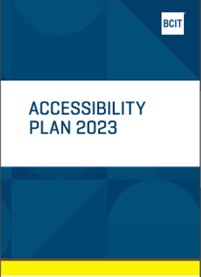BCIT campuses are located on unceded Indigenous land belonging to the Coast Salish peoples, including the territories of the xʷməθkʷəy̓əm (Musqueam), ), Sḵwx̱wú7mesh (Squamish), and Səl̓ílwətaɬ/Selilwitulh (Tsleil-Waututh) Nations. We are grateful for and humbled by the opportunity to work and learn here.
BCIT’s Accessibility Plan

BCIT’s Accessibility Plan is now available.
If you require the document in an alternative format, please email respect@bcit.ca
BCIT’s commitment to accessibility
At BCIT, we are striving to create a fair, equitable, and welcoming community culture that will include, engage, and connect all members of our community. This culture must permeate all aspects of BCIT and everyday interactions with one another. Our goal is to create a holistic environment in which everyone can engage with the highest degree of confidence, security, and agency.
We are committed to ongoing identification and removal of all barriers that prevent full and meaningful participation in all facets of campus life. We will exceed all applicable legislation, including full compliance with the standards specified under the Accessible British Columbia Act (ABCA).
Purpose and mandate
BCIT has established the Accessibility Steering Committee (BCIT ASC). The purpose of these Terms of Reference is to direct and guide the committee in carrying out its roles and responsibilities.
The Accessibility Steering Committee will promote the Institute’s compliance with each standard that is regulated under the Accessible British Columbia Act, develop and update from time to time an Accessibility Plan, and establish an Accessibility Feedback Process.
In addition, the committee’s mandate is to help the Institute implement relevant parts of the Strategic Plan, in particular: Empowering People; Shaping BC; and aligning with our values of Championing Diversity and Inclusion, Engaging with Respect, and Pursuing Collaboration.
Guiding principles
The committee must have regard for the following principles in carrying out its mandate:
- Access: Persons should have barrier-free access to education, services, places, events, and other functions that are generally available to BCIT community members;
- Equity: Persons should have barrier-free access to those things that will give them equity of education, opportunity and outcome;
- Universal design: Access should be provided in a manner that does not establish or perpetuate differences based on a person’s disability; and
- Systemic responsibility: The responsibility to identify, prevent, and remove barriers rests with the person or organization that is responsible for establishing or perpetuating the barrier.